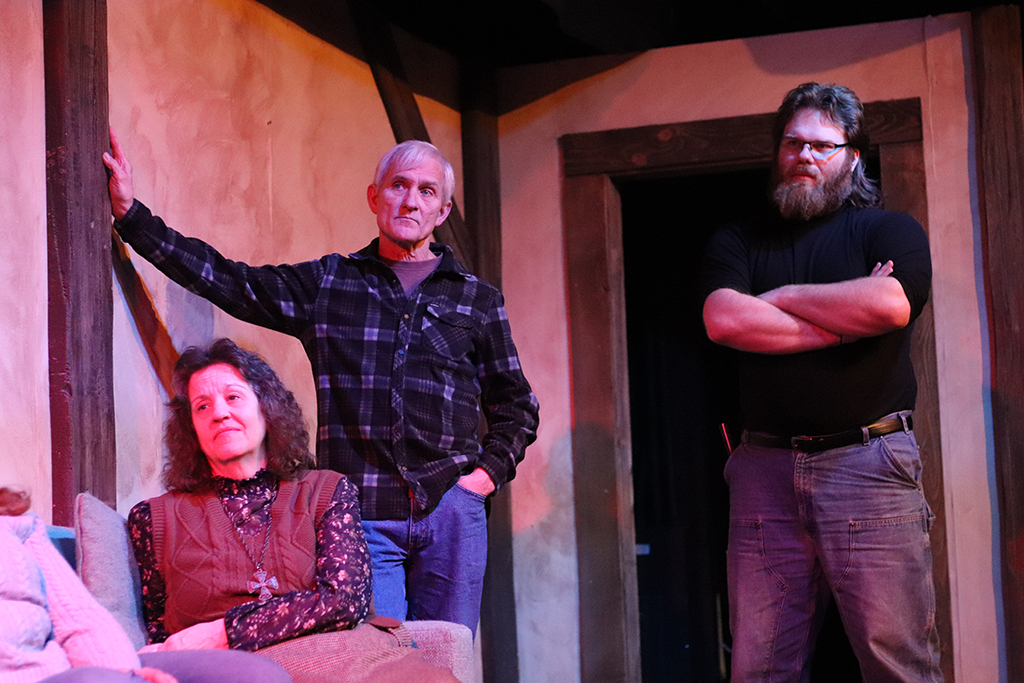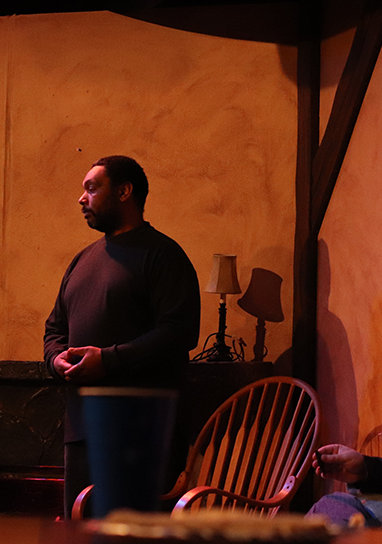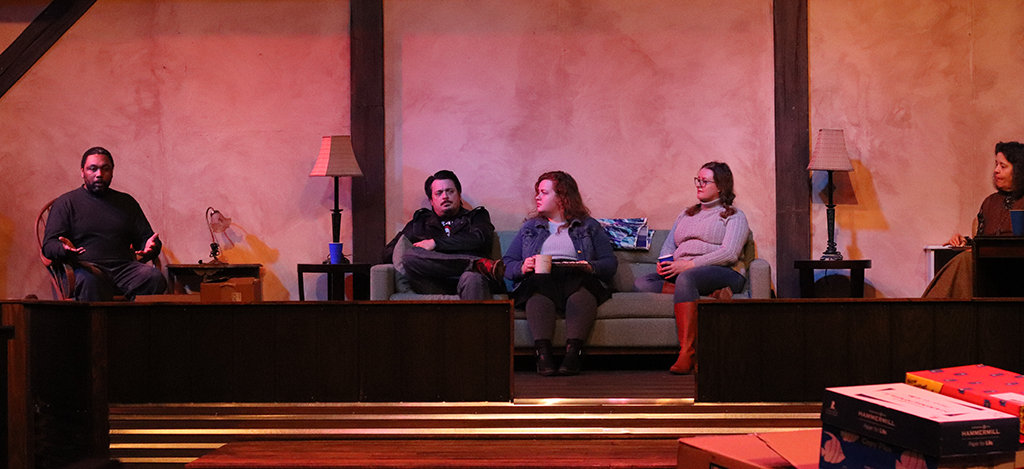by Molly Walsh
If your close friends gathered together for a colleague’s retirement party, what would you think if your colleague began to weave tall tales of everyday life during the Paleolithic period, and historical artifacts rarely found outside a museum were casually lying around his home? Would you believe him if he revealed to you that he has been alive for 14,000 years?
Science fiction writer Jerome Bixby’s “The Man from Earth” explores the nature of life, culture, faith, philosophy, and human history through the lens of John Oldman, who has lived countless lifetimes, ten years at a time. “The Man from Earth” was originally penned as a screenplay by Bixby. A prolific short story writer, Bixby’s work came to life through episodes of television shows like “Star Trek” and “The Twilight Zone” in the 1960s. After completing “The Man from Earth” shortly before his death in 1998, the screenplay was eventually made into an independent film in 2007 and was later adapted to the stage by Richard Schenkman.
Olympia Little Theatre’s production of “The Man from Earth” is directed by Robert McConkey, who has most recently directed “Clue: On Stage” for OLT in 2022. “The Man from Earth” opened on January 27 to a full house and will run through February 12. The general run time for this production is about 90 minutes and there is no intermission. It should also be noted that the entrance and exit to the theater space is also used as a stage entrance for several characters through the course of the play.

The play’s script is something of a philosophical experiment, with heavy dialogue around the course of human history, from early human ancestors to the first agricultural societies to the evolution of cities. Woven through this history lesson is naturalistic dialogue and sharp commentary on religion, faith and the nature of humanity.
OLT’s production was able to carry the weight of these topics, while also injecting well-timed humor into the story. The acting felt comfortable, the interaction between characters felt natural and realistic and the cast had good chemistry. The aesthetics were relatively timeless, and the production was well-blocked, with full use of the theater’s stage space.
With six to eight characters onstage during any given scene, there were also well-placed nonspeaking interactions between actors, and each actor continued to remain active in their character, even if they weren’t the focus of the scene. Whether tidying up, preparing drinks, or chatting amongst themselves, the use of these continuous actions helped to bring each scene to life and to create a more immersive and realistic atmosphere for the audience. This was especially important for this production, since the majority of the play takes place within a single living room setting.
The configuration of OLT’s theater space was also well used for this production, by creating an “outdoor” set in the foreground and an “indoor” set in the background. The production also used realistic sound effects, including ringtones, and car and motorcycle sounds to indicate the arrival or departure of characters.
The production opens with John Oldman (Mark Peterson), a college history professor, entering the living room of his cabin home. Surrounded by moving boxes, John removes the paintings that are hanging on the wall and packs them into the back of his moving trailer outdoors. Soon after, his good friends and colleagues arrive at his cabin to celebrate his retirement and to say goodbye before he leaves town.

At the outset, there are hints that something is amiss. An inscribed Van Gogh painting is amongst John’s possessions, and other mystery artifacts that date back millennia are casually lying around his living room. These small curiosities don’t deter John’s friends from beginning the party though, and they begin to dig into snacks and pour a round of drinks. This production’s use of humor is emphasized at this point in the play, as it becomes clear that the general audience knows more about John’s true identity than many of the play’s characters.
As the party continues, the philosophical and historical discussions grow more serious, as John and his friends begin to recount the highlights of early human history. As academics from different disciplines, each character brings their own expertise to the subject at hand, from psychiatry to biology, to Christian literature.
Puzzle pieces continue to fit together until John makes the big reveal: that he has been alive for 14,000 years and hasn’t aged past the age of 35. Throughout the course of his extended lifespan, John has experienced many wars, empire shifts and major historical events, although his personal memories of these events remain spotty. Stunned by the news, his friends react with a mix of disbelief, exasperation and curiosity.
McConkey and the cast of OLT’s production lead up to this reveal by leaning into the humorous naivety of John’s friends. Many audience members are likely to have read at least a brief synopsis of the show, so the hints to John’s true identity continue to mount and create a humorous tension between the character and viewer. This production also has an emotional resonance, especially as philosophical discussions about love, faith and mortality grow deeper as the narrative progresses.
In one scene, John and the character Sandy (Erin Manza Chanfrau) have a private discussion outside of John’s cabin as they carry boxes to the moving trailer. Sandy shares romantic feelings for John and is interested in pursuing a relationship, even after learning of his true identity. John insinuates a reciprocation for Sandy’s feelings, but is hesitant to move forward with a relationship, recounting that he has seen too many loved ones grow old and pass, as he remains the same age.
“I can’t give you forever,” says John.
“What is forever and who ever really has it,” Sandy asks in response.
This scene was artfully carried out by Peterson and Chanfrau, as it explored the complexities of love and differing philosophies of living in the present moment.
Emotions also grew tense later on in the production, with deeper discussion of world religions and the concept of faith. The character of Edith (Debbie Sampson), an art history professor and devout Christian, especially stands out during these scenes as the character vociferously defends and contemplates her faith and belief in the Bible, which is contrasted with other characters’ views and experiences.
A large portion of the play’s tension comes from the character of Will Gruber (Dennis Rolly), a psychiatrist who has recently lost his wife. News of John’s true identity and subsequent philosophical discussions upset a grieving Will and many of the play’s later emotional plot points revolve around interactions between John and Will.
“The Man From Earth” has a universal appeal with its tension and consistent twists. It could be a particularly interesting production for those who love the science fiction genre or for those who enjoy the topics of philosophy, world religion and the nature of faith. The humor and banter between characters as well as the ever-turning plot, though, make it entertaining for a wider audience.
In addition to “The Man from Earth,” OLT’s current season will include productions of “One Slight Hitch” by Lewis Black and “Into the Breeches!” by George Brant.
WHAT
Jerome Bixby’s The Man from Earth at the Olympia Little Theatre
WHEN
7:25 p.m. Jan. 27-28
1:55 p.m. Jan. 29
7:25 p.m. Feb. 3, 4, 9, 10, 11
1:55 p.m. February 5
WHERE
Olympia Little Theatre, 1925 Miller Ave NE, Olympia
COST
$11-15
LEARN MORE
http://www.olympialittletheater.org/shows/
Phone: 360-786-9484
Photos Robert McConkey

